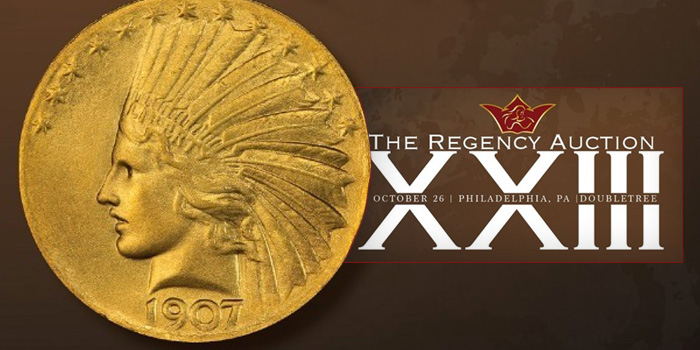
By Charles Morgan and Hubert Walker for CoinWeek …..
Count us as people who appreciate the rationale behind Legend Rare Coin Auctions’ Regency Sales. The series has always promised curated high eye appeal coins, drawing largely from the collections of Legend’s clients. It’s this familiarity with the product, coupled with the premise of “all wheat, no chaff” that puts the PQ Type collectors in us on notice every time we get one of their hardbound catalogs in the mail.
In 2017, the firm has raised the stakes.
Regency XXII brought record prizes for the Northern Lights Collection of toned Morgan dollars, including $293,750 USD for a PQ 1892-S Morgan dollar and $61,687.50 for the spectacular Sunnywood-Simpson 1880-S (that’s a type coin, ladies and gentlemen… except when it comes bathed in color and grades out at MS68+ CAC!).
It turns out that these were just the appetizers, as the Regency XXIII Sale–to be held on the evening of October 26, 2017 at the PCGS Members Only Show in Philadelphia–will stand as the firm’s most impressive offering yet. With over 548 lots, the sale includes two world-class gold collections; spectacular type coins and patterns; and a number of superior eye appeal, conditionally rare modern coins like an offering of toned American Silver Eagles. It also includes what is arguably the most valuable Morgan dollar, the Vermeule-Coronet 1893-S (in PCGS MS67).
We spent the better part of a weekend studying the catalog and present the following lots you need to know.
Lot 4161: 1909 Liberty Head 5¢ PCGS PR67+ DCAM CAC
… and you thought we’d only talk about the headliners?
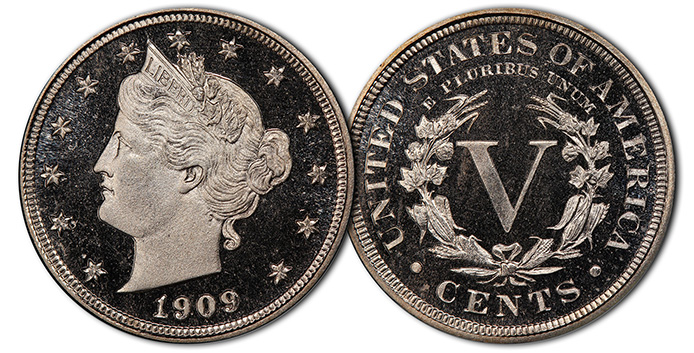
Liberty Head nickels were the first coins that Charles really fell in love with. As a series, they straddle the line between the antiquarian and the modern. It’s funny to think about it, but the entire series was struck within the span of time that the Morgan dollar was struck, but we often discount that due to the fact that the Morgan dollar, for all intents and purposes, ceased to be after its 1904 issue. Barber’s minor coin would continue its run for eight more years–nine if you account for the output of the midnight minting of five Proofs in 1913.
The United States Mint distributed 4,763 Proof nickels of the 1909 issue, making it by far the most plentiful Proof 20th-century nickel until they topped that number with the issue of the 1937 Proof Set. In the Liberty Head series, only the 1883 issue was struck in higher numbers. It’s probably safe to assume that 60-70% survive in various states of preservation, with the majority falling within the choice to gem grades of PR63-PR65.
PCGS reports 1,449 total grading events for the issue, with 12.89% earning Cameo, and a tiny sliver of a fraction (0.7%, or 11 pieces) earning Deep Cameo. Deep Cameos tend to come gemmy, with nine of the 11 coins earning PR66 or better.
The present example is the PCGS plate coin for the issue (DCAM tab), and of only two top pop PR67+DCAM coins it’s the less hazy of the two. The faintest hint of schmutz on the 10th star (immediately to the right of Liberty’s bun) is not apparent on the PCGS Coinfacts image, leading us to believe that this was dust or some other substance present on the holder when it was being photographed for the catalog.
Current Bid: $19,500
Lot 159: 1942-P Jefferson 5¢ Type 2 PCGS MS68

The War Nickel set of 1942-1945 offers Felix Schlag’s Jefferson design at its most brilliant and distinguished. The softer metal content of 56% copper, 35% silver, and 9% manganese strikes up much better than the standard tenor of 75% copper and 25% nickel, giving the coins an instantly recognizable look. Even in circulated grades, one should be able to easily discern the type without flipping the coin over to look for the oversized mint marks that surmount Jefferson’s Monticello.
In grades up to MS66, a collector with a budget of up to $100 per coin can assemble a wonderful set of high-eye-appeal coins. Those wishing for VSOP over XO, will likely look at MS67 coins with or without Full Steps, depending on the issue. In MS68, the type is rare for all of the ’42-’45 issues.
Case in point: the 1942-P Type 2 offered in Regency XXIII is the sole finest graded by PCGS (NGC reports a population of three in MS68).
The coin exhibits thin bands of rainbow toning around the motto and legend and is bathed in gold, green, and rose de sable. This is a standout example! In 2014, Heritage Auctions sold one of the three NGC MS68 coins for $4,112.50. Six months later at Long Beach, Heritage sold the then-finest in a PCGS holder MS67+ for $4,230. It will be interesting to see how this piece reshapes the market for the high-end 1942-P Type 2 nickel.
Current Bid: $1,950
Lot 223: 1904 Barber 25¢ NGC PF69
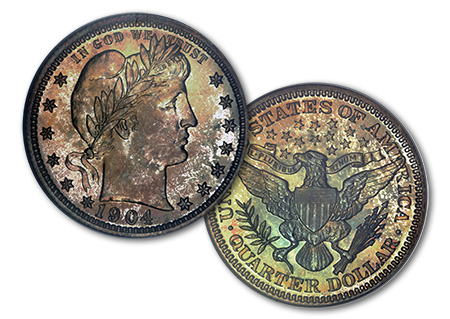
Modern Proofs are struck with the utmost in care, almost immediately entombed in a plastic holder and then shipped off to customers. For the majority of these coins, if submitted to a third party grading service, the choice between PR69 and PR70 comes down to minute differences that would likely go undetected by a majority of collectors. For a 1904 Barber quarter to be struck at such a high quality and then survive more than one hundred years with nary a fleck, hairline, or other grade delimiting blemish is the stuff of science fiction. Yet, here we are: lot 223, in an older generation NGC holder is a toned example in the nearly impossible vintage coin grade of PF69. This virtually flawless coin exhibits olive and goldenrod coloration atop a coin that exhibits deeply mirrored fields and lightly frosted devices.
For all dates, NGC accounts for 34 total PF69 Barber quarters across the entire series. It is the sole finest in the grade for the issue, and were the coin to upgrade to PF69CA, it would be the sole finest of a population of 21 examples. This piece once belonged in the Greensboro Collection, which, was written about extensively by CoinWeek writer Greg Reynolds, who wrote of the collector’s Barber quarter set:
Clearly, Greensboro planned to acquire Proof Barber Quarters that are certified as grading from 67 to 69, and he succeeded. In my view, these brought strong prices at the auction. Indeed, many sold for above-market prices.
Pre-sale estimate on the piece is $28,000 – $30,000.
Current Bid: $0
Lot 412: 1836 Gold $1 Pattern, Judd-67. PCGS PR66 CAM CAC
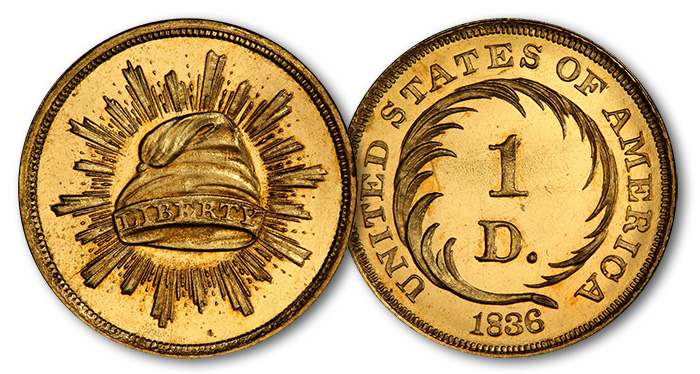
In 1836, the United States Congress considered a proposal from members of the Southern delegation to authorize the striking of gold one dollar coins. Later dropped from what became known as the Coinage Act of 1837, the provision called for the striking of gold dollar pieces “of which the weight shall be 25 grains and eight-tenths of a grain…”. If enacted, the diminutive new denomination would have enjoyed unlimited legal tender status.
It’s a shame that the design was never adopted. It’s instantly recognizable: a pileus, or liberty cap, centered amongst a glory of sun rays. And on the reverse a palm frond, along with the simple yet to the point denomination of 1 D. Multiple variants of the design exist as do restrikes. This example is original, presumably struck in the spring of 1836.
Last the coin was offered, it was in a different PCGS holder, but at the same grade of PR66 CAM, where it brought $30,550 at Heritage Auctions’ 2014 ANA US Coins Signature Sale. The tiny tick at six o’clock plus a few other markers on the coin make for an easy match to the present piece. The PCGS Coinfacts image offers prospective buyers the best online view of this scarce gem.
Pre-Sale Estimate: $32,000 – $36,000
Current Bid: $23,000
Lot 440: (1965) 50¢, Judd-2131. Copper-Nickel. PCGS MS67 CAC
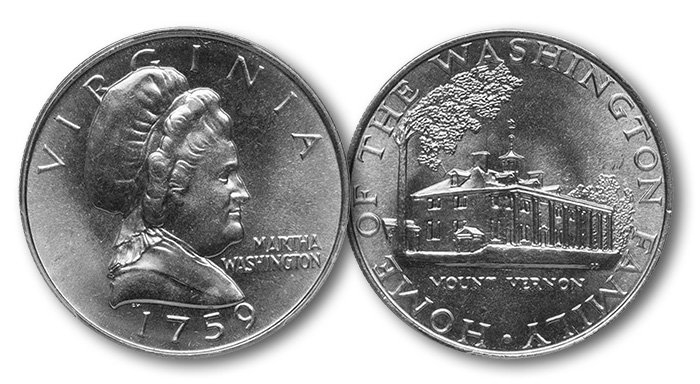
The shift from 90% silver to copper-nickel posed a number of challenges for the United States Mint, especially given the fact that the Treasury anticipated the need to replace virtually every single dime, quarter, and half dollar in circulation with a base metal coin. Of course, public pronouncements by government officials suggesting that silver and clad coins would circulate side-by-side forever did little to alter the reality of Gresham’s Law and “bad” money chased “good” out of circulation within a matter of just a few years.
We suspect that the government also had a hand in the matter, recalling its own coins and circulating the 1965-dated coins as it had the means to.
This pattern, featuring a bonnet-wearing Martha Washington on the obverse and Mount Vernon on the reverse was struck in dime, quarter, and half dollar sizes but lacks the inscriptions normally found on an official U.S. coin. The Mint struck numerous versions in a variety of metal compositions as it sought to get the new tenor exactly right.
Graded PCGS MS67, this is the finest-known example of an extraordinarily rare and important modern pattern coin.
Pre-Sale Estimate: $7,500 – $10,000
Current Bid: $6,500
Lot 441: Original 1902 Gold Proof Set, PCGS PR65-PR67 CAC
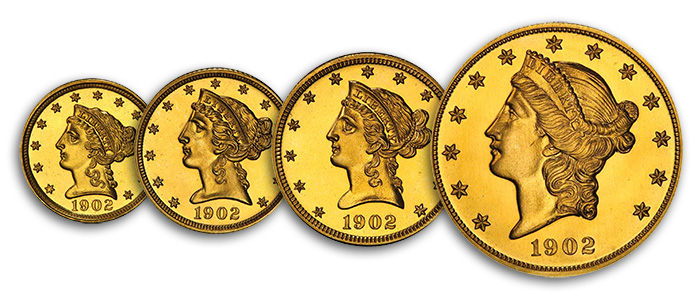
The 1902 Gold Proof Set consists of four pieces: a quarter eagle ($2.50), a half eagle ($5.00), an eagle ($10), and a double eagle ($20). These were the circulating gold denominations of the period. The double eagle contained .9675 ounces of gold in a .900 fine gold and copper alloy.
Sold individually and in sets, the Proof eagle’s distributed mintage of 113 pieces caps the potential number of original (and later assembled sets). Most surviving examples are flawed in some way. In the first two decades of the 20th century, the Mint experimented with various finishes for its Proof issues. This led to an increased sense of collector apathy for Proofs of the period, which is why many are scarcer today than their mintages would otherwise indicate. From 1902 to 1907, Proof coins displayed a semi-brilliant finish.
The $20 gold in this set is graded PR65+ by PCGS. Only one example in PR66+ has been reported by the service. The $10 is top pop, pop one at PR67. The $5 at PR65 is one of two graded at that level with one finer. The $2.50 at PR65, however, is the only coin in the set where there is any clear room for improvement. It is a pop 12 coin with six finer.
Legend expects this set to hit $300,000 to $350,000. We expect it to easily hit that.
Current Bid: $250,000
Lots 442-474: Crow River Collection of $10 Indian Gold
The Crow River Collection of $10 Indian gold coins is the current second-finest active set of the PCGS Set Registry. The 93.75% complete set has a weighted GPA of 65.38 and a Set Rating of 58.05. It is bested by the G & J Lott Collection, which is 100% complete. Two important coins worth approximately $1 million separate the sets: the 1907 Rolled Edge Type and the fantastically rare 1933 (312,500 were minted; fewer than 50 are known).
Beyond these two coins, the Crow River Set compares favorably: 19 Crow River coins are finer (sometimes much finer); five match the grade of the G & J Lott set coins; and only six pieces grade lower: the 1908 MS67 to MS66+; the 1911-D MS64 to MS63+; the 1914-S MS65 to MS64+; the 1920-S MS64+ to MS63+; and the 1930 MS65+ to MS64.
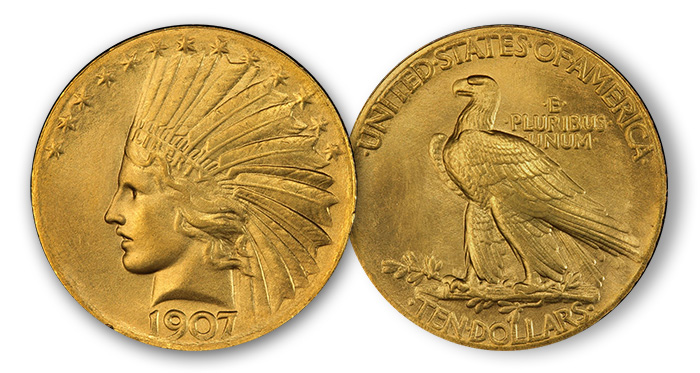
Lot 442 is the 1907 Wire Rim $10 in MS66 CAC. You would have to be extremely fussy to find this example not to your liking. It has beautiful satiny surfaces, a strong strike for the type, and is absent any distracting marks, blemishes, or planchet imperfections.
Pre-Sale Estimate: $110,000 to $120,000.
Current Bid: $92,500

Lot 450 is a PCGS MS66 example of the under-appreciated 1909-D, a difficult coin to find in all gem grades. PCGS has certified only 11 examples at MS65 or better, with just four in MS66 and two in MS67. The Crow River specimen features a beautiful mellow gold color with hints of toning.
Pre-Sale Estimate: $45,000 to $50,000
Current Bid: $30,000
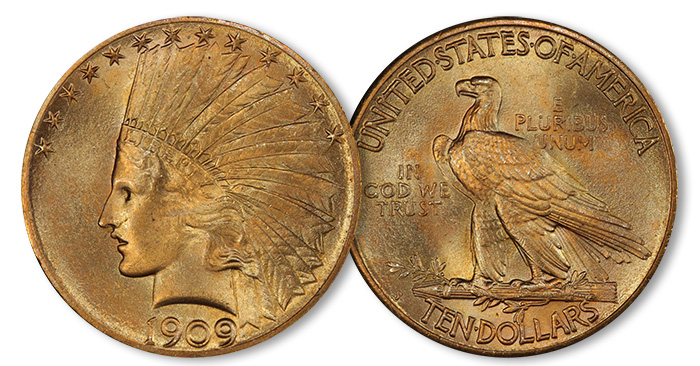
Lot 451 is an extraordinary 1909-S in MS66+. It is an important offering. Two finer examples reside in PCGS holders, according to current population data, but this example is about as fine as they come for Saint Gaudens’ masterpiece. We like the mellow patches of swirling color that this example exhibits and the strike is full and forceful. Best of luck topping a coin like this, especially for a tough date lake the 1909-S. Current Bid is already between the wickets of the pre-sale estimate. Expect it to leapfrog over the high number into the mid-60s.
In a different PCGS holder (same grade), this same example brought $55,812.50 at Stack’s Bowers 2013 ANA Auction.
Pre-Sale Estimate: $50,000 to $55,000
Current Bid: $52,500

The Crow River 1920-S in MS63+ CAC (Lot 468) is one of the most interesting coins in the set, insofar as it really plays within the psychology and aspirations of a collector.
In choice grades, one expects marks and hits, but this coin is mostly free of chatter – save a little on field behind E PLURIBUS UNUM on the reverse. No, instead, what delimits the grade are two hits: one on the eagle’s headdress (which, we believe, is forgivable under the circumstance that this is one of the 20th century’s great rarities), and another, a deep horizontal hit, on the bird’s chest. Without that hit, we think you’re looking at a coin that approaches MS65, and a coin that would in that circumstance bring $200,000 to $250,000 at auction.
With a coin this rare, and this well-struck, sometimes you take what you can get or what you can afford. For a collection so full of perfection, it’s fascinating to see the rare instance of compromise. At these price levels, who can blame them?
Pre-Sale Estimate: $120,000 to $130,000
Current Bid: $95,000
Further Insights:
Also Worthy of Note:
Lot 160: 1959 Jefferson 5¢ PCGS MS67FS. Ultra-high-end example of a tough date to get in Superb Gem with Full Steps. Without the steps this is a $150-$200 coin. Current bid: $6,750.
Lot 161: 1951 Jefferson 5¢ PCGS PR67+DCAM. Easily one of the finest that exist. Pre-1964 Proof Sets of the modern period in Deep Cameo will be the next century’s perennial favorites. At today’s prices, these coins are bargains.
Lot 224: 1909 Barber 25¢ PCGS PR67+ CAC. Formerly a Newman coin (NGC PR68* CAC). PCGS downgraded the coin a smidgen. In the modern period, it first came to market in 2013, where it sold for $18,800. In 2015, Heritage offered it again, where it sold for $13,512. Legend pre-sale estimate of $7,500 to $8,500. What are we missing?
Lot 236: 1940 Washington 25¢ PCGS MS67+ CAC. Superior in eye appeal to the toned example (with fingerprint!) that Legend sold in 2015 for $1,351 and the darkly toned example that Heritage sold for $1,292.50 in 2016.
Lot 388: 1893-S $1 PCGS MS67 CAC. The Vermuele-Jack Lee-Coronet 1893-S. The coin was once only rivaled by the Norweb coin (RIP). Finest known of the most important circulation strike of the popular Morgan dollar series.
Lot 433: 1879 Silver Pattern 50¢, Judd-1597. PCGS PR67 CAM CAC. One of the finest examples in existence. The rivalry between U.S. Mint engravers Charles Barber and George T. Morgan is the stuff of legend – some of it true, some of it apocryphal. Having said that, the “Washlady” pattern coins and other Barber works of the period show the engravers in the midst of a numismatic “Epic Rap Battle”. Who won? You decide.
Lot 463: 1914-D Liberty $10 Gold PCGS MS67 CAC. Crow River Collection. Another wow coin from the Crow River Collection. Stunning eye appeal and subdued gold color.
Lot 515: 1906 Liberty $20 Gold PCGS MS65 CAC. The $20 Liberty gold series is the Mount Everest of classic U.S. gold types. In gem uncirculated condition (or finest known), a complete set has never been assembled. This piece realized $32,200 when it was last offered in 2013. No gem 1906 $20 Lib has been offered at auction since.
* * *
Connect with Legend Rare Coin Auctions on social media:




